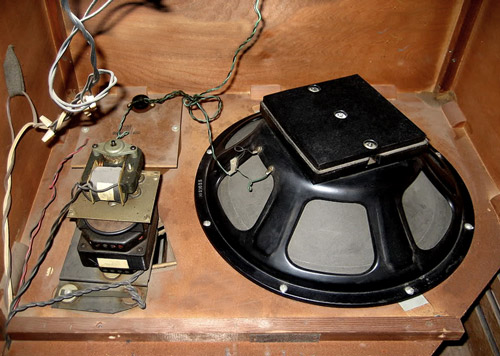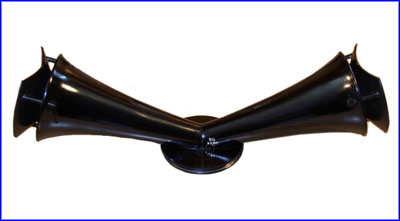LESLIE SPEAKERS
North Suburban HAMMOND ORGAN Service

Figure 4. Interior of typical Leslie. Note the small motor mounted on the larger motor which gives two very different RPM settings for the rotor below the speaker. Just a little of the belt is visible through the hole in the center shelf to the right of the motors.

Figure 5. Top rotor assembly from typical Leslie. The round, disc-like central section is the pulley to receive the drive belt. Notice also the deflector cones in each horn. These greatly smooth out the tremolo effect which, without the deflector cones makes the speaker sound very choppy. However, some musicians prefer that effect and remove the deflectors. Note also the the top of each deflector has a slight cutout. This is to make sure that the rotor clears the underside of the top of the cabinet.
Here is a look inside the central compartment of a typical Leslie which shows the fifteen inch speaker, the two-speed motor stack, and also the crossover network just behind the motors. To the lower right, you'll notice that there is a triangular cutout in the shelf where the speaker is mounted. This is the vent port that, when the back cover is in place, makes the central compartment of the Leslie cabinet a bass reflex speaker enclosure.
In the second picture, we have a look at the upper horn rotor which mounts on a short extension tube on the treble driver. Only one of these two horns is active. The other is a dummy and exists only to provide balance and identical windage effects so that when this rotor is spinning at 360 to 400 RPM, it will not create any wobble or extraneous vibration.
In a typical Leslie, the motor pulley for the top rotor has three grooves, each with a slightly different diameter so that the user can select either a slow or fast vibrato/tremolo effect in addition to the normal speed which seems to be, confirmed by actual tachometer measurement, around 370 RPM averaged from three different Leslies. We should add that in newer Leslies, multiple groove pulleys and double motor stacks have been eliminated and replaced by DC servo motors, variable speed motors that will run at a constant RPM rate for whatever speed is selected. In the traditional Leslies with the three-groove motor pulleys for the upper rotors, there is also a spring-loaded idler pulley that maintains tension on the belt at all times regardless of which groove the user selects.
This is very close to the slightly slower 367 RPM of the bass rotor and in listening to a Leslie in operation, this slight difference in rotational speeds is not noticeable. It appears to be an interesting auditory illusion, but to me, when I hear a Leslie with either the slow or the fast groove selected, it sounds as though both the upper AND lower rotors have been reduced or increased in speed.
What we have looked at so far is the traditional Leslie. There are, however, many variations on this. Some are specific to certain electronic organs. There is also a slightly different cabinet style available that is supposed to look a little better in a home. The essential operation of this Leslie is the same as the standard type, but the compartments are arranged differently so that the over-all height of the cabinet is lower and the cabinet is longer. Purists say that this style of Leslie does not sound as good as the regular type. I have not really noticed any difference between the two types. Rather, I have noticed many differences between different Leslie installations.
We should mention the so-called tall Leslies, which were the predecessors of the ones that are so ubiquitous today. One of the best known was the 31H. The essentials are the same, a 15" bass woofer in the middle compartment, a scooplike rotor below the 15" speaker and a similar rotating horn in the top. Two major differences are that the central and top compartments are bigger, and the power amplfier in the 31H is located in top compartment rather than in the bottom. The claim is made that because of the larger bass reflex compartment, these give better bass than the newer type and they are much sought after by some Hammond players. Having had a 31H for many years, I can attest to the fact that they do give really good pedal bass, along with of course the traditional Leslie tremolo/vibrato. ON the down side, they are huge, about the same height as a typical refrigerator. On the next page we have a couple of pictures of a 31H Leslie.
Previous Page Page 6. Next page